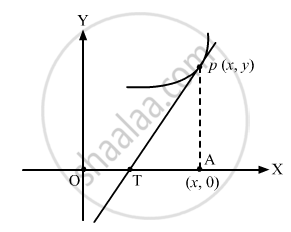Advertisements
Advertisements
Question
Find the equation of the curve which passes through the point (1, 2) and the distance between the foot of the ordinate of the point of contact and the point of intersection of the tangent with x-axis is twice the abscissa of the point of contact.
Solution

It is given that the distance between the foot of ordinate of point of contact (A) and point of intersection of tangent with x-axis (T) = 2x
\[\text{Coordinate of }T = \left( x - y\frac{dx}{dy}, 0 \right)\]
\[\Rightarrow y - 0 = \frac{dy}{dx}\left(x - \left( x - y \frac{dx}{dy} \right) \right)\]
\[\Rightarrow y \frac{dx}{dy} = 2x\]
\[\Rightarrow \int\frac{dx}{x} = 2\int\frac{dy}{y}\]
\[\Rightarrow \ln x = \ln y^2 + \ln c\]
\[x = c y^2 \]
\[\text{As the circle passes through }\left( 1, 2 \right).\]
\[1 = c \times 2^2 \]
\[ \Rightarrow c = \frac{1}{4}\]
\[ \Rightarrow 4x = y^2\]
APPEARS IN
RELATED QUESTIONS
Find the differential equation of all the parabolas with latus rectum '4a' and whose axes are parallel to x-axis.
Form the differential equation of the family of hyperbolas having foci on x-axis and centre at the origin.
Show that the function y = A cos 2x − B sin 2x is a solution of the differential equation \[\frac{d^2 y}{d x^2} + 4y = 0\].
Show that y = AeBx is a solution of the differential equation
Show that Ax2 + By2 = 1 is a solution of the differential equation x \[\left\{ y\frac{d^2 y}{d x^2} + \left( \frac{dy}{dx} \right)^2 \right\} = y\frac{dy}{dx}\]
Show that y = ax3 + bx2 + c is a solution of the differential equation \[\frac{d^3 y}{d x^3} = 6a\].
Hence, the given function is the solution to the given differential equation. \[\frac{c - x}{1 + cx}\] is a solution of the differential equation \[(1+x^2)\frac{dy}{dx}+(1+y^2)=0\].
Verify that \[y = e^{m \cos^{- 1} x}\] satisfies the differential equation \[\left( 1 - x^2 \right)\frac{d^2 y}{d x^2} - x\frac{dy}{dx} - m^2 y = 0\]
Differential equation \[\frac{dy}{dx} + y = 2, y \left( 0 \right) = 3\] Function y = e−x + 2
(sin x + cos x) dy + (cos x − sin x) dx = 0
xy (y + 1) dy = (x2 + 1) dx
tan y dx + sec2 y tan x dy = 0
Solve the following initial value problem:-
\[\frac{dy}{dx} - 3y \cot x = \sin 2x; y = 2\text{ when }x = \frac{\pi}{2}\]
Solve the following initial value problem:-
\[\tan x\left( \frac{dy}{dx} \right) = 2x\tan x + x^2 - y; \tan x \neq 0\] given that y = 0 when \[x = \frac{\pi}{2}\]
If the marginal cost of manufacturing a certain item is given by C' (x) = \[\frac{dC}{dx}\] = 2 + 0.15 x. Find the total cost function C (x), given that C (0) = 100.
The rate of increase of bacteria in a culture is proportional to the number of bacteria present and it is found that the number doubles in 6 hours. Prove that the bacteria becomes 8 times at the end of 18 hours.
The integrating factor of the differential equation \[\left( 1 - y^2 \right)\frac{dx}{dy} + yx = ay\left( - 1 < y < 1 \right)\] is ______.
Solve the following differential equation : \[y^2 dx + \left( x^2 - xy + y^2 \right)dy = 0\] .
Verify that the function y = e−3x is a solution of the differential equation \[\frac{d^2 y}{d x^2} + \frac{dy}{dx} - 6y = 0.\]
Solve the following differential equation.
y2 dx + (xy + x2 ) dy = 0
Solve the following differential equation.
x2y dx − (x3 + y3 ) dy = 0
Solve the following differential equation.
`dy/dx + 2xy = x`
Select and write the correct alternative from the given option for the question
Differential equation of the function c + 4yx = 0 is
Solve the differential equation `("d"y)/("d"x) + y` = e−x
Solve the following differential equation `("d"y)/("d"x)` = x2y + y
Solve the following differential equation
`yx ("d"y)/("d"x)` = x2 + 2y2
Solve the following differential equation
sec2 x tan y dx + sec2 y tan x dy = 0
Solution: sec2 x tan y dx + sec2 y tan x dy = 0
∴ `(sec^2x)/tanx "d"x + square` = 0
Integrating, we get
`square + int (sec^2y)/tany "d"y` = log c
Each of these integral is of the type
`int ("f'"(x))/("f"(x)) "d"x` = log |f(x)| + log c
∴ the general solution is
`square + log |tan y|` = log c
∴ log |tan x . tan y| = log c
`square`
This is the general solution.
The integrating factor of the differential equation `"dy"/"dx" (x log x) + y` = 2logx is ______.
If `y = log_2 log_2(x)` then `(dy)/(dx)` =
The differential equation (1 + y2)x dx – (1 + x2)y dy = 0 represents a family of:
Solve the differential equation
`x + y dy/dx` = x2 + y2
